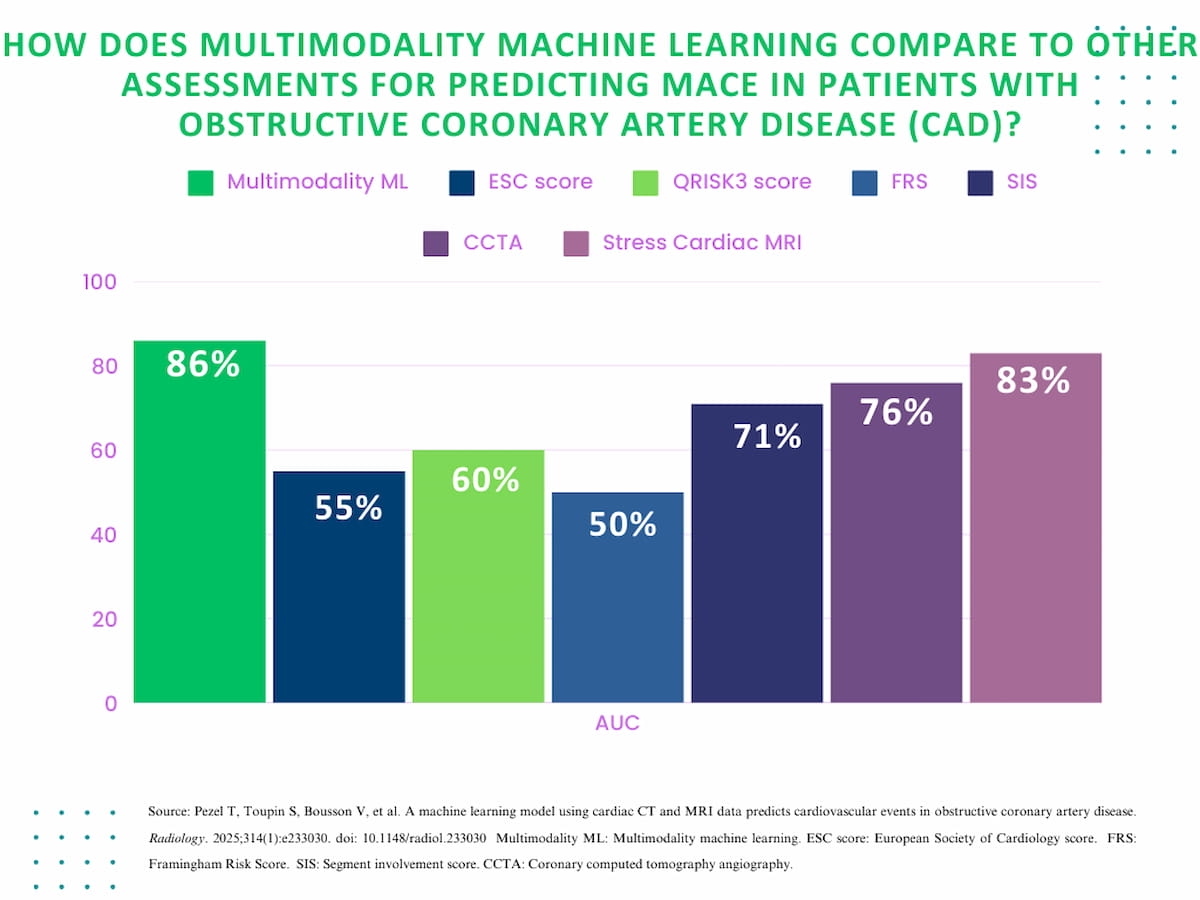An emerging multimodal machine learning (ML) model may provide enhanced prediction of major adverse cardiovascular events (MACE) in comparison to traditional assessments in patients with newly diagnosed obstructive coronary artery disease (CAD).
For the retrospective study, recently published in Radiology, researchers evaluated the ML model for the prediction of MACE in 2,038 patients with obstructive CAD and a mean follow-up of seven years. The machine learning model incorporated nine coronary computed tomography angiography (CCTA) parameters, 12 cardiac magnetic resonance imaging (MRI) factors, two electrocardiogram measures and 18 clinical factors, according to the study authors.
The researchers found the ML model provided an 86 percent area under the receiver operating characteristic curve (AUC) in predicting MACE in comparison to CCTA alone (76 percent) and stress cardiac MRI alone (83 percent). The study authors also pointed out the multimodal ML model AUC was 31 percent higher than the European Society of Cardiology score (55 percent) and 36 percent higher than the Framingham Risk Score (50 percent).
“The study presents the first large-scale investigation, to our knowledge, of an ML model for prognostic risk evaluation using combined CCTA and stress cardiac MRI data and suggests that ML and multimodality
imaging could have an important clinical role for risk stratification in patients with CAD,” wrote lead study author Theo Pezel, M.D., who is associated with the Department of Cardiology at the Multimodality Imaging for Research and Analysis Core Laboratory (MIRACL.ai), and colleagues.
In two sets of external validation testing, the ML model demonstrated an average sensitivity of 60.5 percent and average positive predictive value (PPV) of 45.5 percent. However, the study authors also noted the ML model offered averages for AUC at 88 percent, accuracy at 88.5 percent, specificity at 92 percent and negative predictive value (NPV) at 94.5 percent.
(Editor’s note: For additional content on MRI, click here.)
Three Key Takeaways
1. Superior predictive performance. The multimodal ML model demonstrated an 86 percent AUC for predicting major adverse cardiovascular events (MACE), outperforming traditional assessments like CCTA alone (76 percent), stress cardiac MRI alone (83 percent), the European Society of Cardiology score (55 percent), and the Framingham Risk Score (50 percent).
2. Enhanced risk stratification. By integrating data from CCTA, cardiac MRI, ECG, and clinical factors, the ML model improved risk stratification, suggesting that ML use of multimodal imaging could play a crucial role in prognostic evaluation for obstructive CAD patients.
3. High Specificity and NPV. In external validation testing, the ML model showed high average specificity (92 percent) and average negative predictive value (94.5 percent), indicating strong reliability in ruling out MACE in patients with low predicted risk.
Emphasizing the “deep integration” of CCTA and cardiac MRI parameters with the ML model, the researchers suggested that ML capabilities to process data from multimodality imaging, which is recommended by current guidelines, can bolster risk stratification in this patient population.
“ML methods are widely used and efficient for analyzing large amounts of data, whereas traditional algorithms falter because of inadequate model complexity. For that reason, ML seems well suited for the comprehensive analysis of complex imaging datasets,” maintained Pezel and colleagues.
(Editor’s note: For related content, see “Meta-Analysis Shows Superiority of CT Angiography Over SPECT and Functional Testing for Obstructive CAD,” “Study Shows CT-Based Coronary Artery Calcium Scores Are Predictive of MACE Risks in Cases of Stable Chest Pain” and “CT-Derived Fractional Flow Reserve Leads to Nearly 20 Percent Reduction of ICA in Cases of Suspected CAD.”)
In regard to study limitations, the authors acknowledged that different definitions of what constitutes MACE criteria may lead to differences with study outcomes. The researchers also conceded a lack of baseline and follow-up data in regard to symptomatology and patient medications as well as a lack of data on the impact of treatment decision changes due to cardiac MRI.
